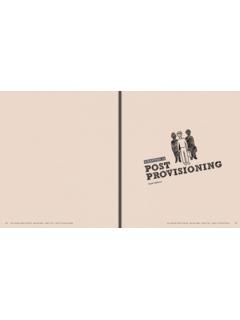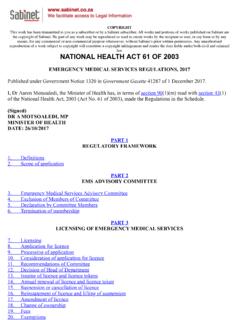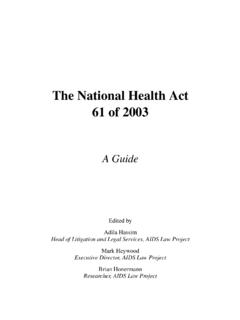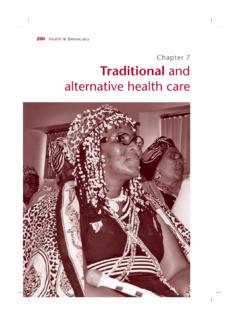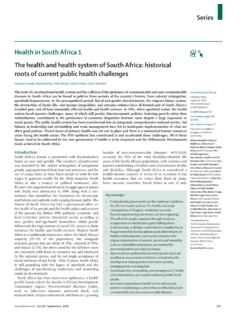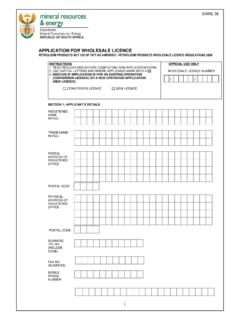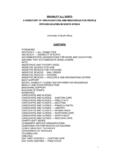Transcription of Health and Democracy-Contents - SECTION27
1 30 Health & DemocracyChapter 2 The Constitution and public Health policyThe Constitution and public Health policy 31 CONTENTS Introducing the Constitution and public Health policy 32 The right of access to Health care services 33 Introducing the Bill of Rights and access to Health care 33 Implications for the development of Health policy 34 Regulating the exercise of public power 45 Key constitutional principles 46 Key constitutional rights 47 Key constitutional structures 50 The structure of government 55 Principles of allocating powers 56 Legislative branch 59 Executive branch 64 Judicial branch 66 Conclusion 6932 Health & Introducing the Constitution and public Health policyThe Constitution of the Republic of south africa , 1996 (the Constitution) is the supreme (highest) law of the land.
2 It is central to developing and implementing Health law and policy, which it regulates in at least fi ve important ways: It regulates the structure of government. It regulates the way in which various branches of government operate. It sets out the framework for raising taxes and allocating revenue. It guides the content of all laws and policies, primarily through its Bill of Rights. It regulates the role of government and non-state actors (such as private corporations) in realising the right of access to Health care services. This chapter does not aim to deal with each aspect of the Constitution. Instead, its focus is limited to three key issues that together set out the broad framework within which Health law and policy is developed and implemented: The right of access to Health care services and its implications for the development of Health policy.
3 How public offi cials can and should exercise the power given to them by law. The structure of the relevant aspects of the Constitution s reach are explored elsewhere. For example: Chapter 3 covers taxation, budgets and state expenditure. Chapter 4 explores the legislative drafting process including amendments to the Constitution and the duty of law-makers to guide public offi cials and hold them to account in exercising the powers given to them by law. Chapter 8 deals with the rights of users of the Health care system. Chapter 10 considers the rights of Health care workers. The Constitution and public Health policy The right of access to Health care servicesIntroducing the Bill of Rights and access to Health careThe Constitution guides the substantive content of all laws and policies through its Bill of Rights, which it describes as a cornerstone of democracy.
4 The Bill of Rights regulates the content of Health laws and policies in two key ways: By recognising a range of fundamental rights that are relevant to the development and implementation of Health policy. By setting out the state s positive and negative duties in relation to these rights. The courts directly enforce the Bill of Rights. They are increasingly having an impact on the way that Health laws and policies are devised and put into practice. Defi ning Health care dutiesPositive duties are obligations that make the state act in certain circumstances and in particular ways (what it must do), while negative duties stop the state from doing certain things (what it must not do).
5 Among other things, section 27 of the Constitution provides as follows: Every person has the right to have access to Health care services, including reproductive Health care . No person may be refused emergency treatment .In general, the state s positive and negative duties are set out in section 7(2) of the Constitution, which requires the state to respect, protect, promote and fulfi l the rights in the Bill of Rights .In relation to Health care services, this means that government must: Respect the right of access to Health care services by not unfairly or unreasonably getting in the way of people accessing existing Health care services, whether in the public or private sector.
6 Protect the right by developing and implementing a comprehensive legal framework to stop people who get in the way of the existing access of others. Promote the right by creating a legal framework so that individuals are able to realise their rights on their Health & Democracy Fulfi l the right by creating the necessary conditions for people to access Health care, by providing positive assistance, benefi ts and actual Health care particular, section 27(2) says that government must take reasonable legislative and other measures, within its available resources, to achieve the progressive realisation of the right.
7 This means taking all reasonable steps to ensure that the right is protected, promoted and fulfi lled, and that over time, universal access to quality and comprehensive Health care is achieved. This can include but is not limited to the passing of laws by Parliament and the provincial 27 does not operate alone. It is but one albeit of central importance among a collection of rights that deal directly and indirectly with Health . These rights, which create entitlements and impose both positive and negative obligations on the state, include the right to bodily and psychological integrity (section 12(2)), the right to privacy (section 14) and the right to an environment that is not harmful to their Health or wellbeing (section 24(a)).
8 But the focus of this chapter, however, remains section 27, dealing with Health care services, including reproductive Health care .Implications for the development of Health policySection 27 recognises that access to Health care is itself a basic human right. It provides us with a strong tool aimed at ensuring Health policy and practice that respond to the needs of all people in south what exactly does the section 27 right mean? What must the state do to enable people to access decent Health care? Can government simply say that it is doing its best within the diffi cult circumstances, or is it required to do something more?
9 This part of Chapter 2 tries to answer some of these questions by focusing on four key Constitutional Court decisions that have a direct impact on developing and implementing Health policy: Soobramoney v Minister of Health (KwaZulu-Natal) 1998 (1) SA 765 (CC) (the Soobramoney case) Government of the Republic of south africa v Grootboom 2001 (1) SA 46 (CC) (the Grootboom case)The Constitution and public Health policy 35 Minister of Health v Treatment Action Campaign (No 2) 2002 (5) SA 721 (CC) (the TAC case) Khosa v Minister of Social Development; Mahlaule v Minister of Social Development 2004 (6) SA 505 (CC) (the Khosa and Mahlaule cases).
10 Not all of these cases deal directly with Health care. The Grootboom case, for example, is about access to adequate housing. But it is nevertheless central to any discussion on the state s positive duties with regard to socio-economic rights. We also do not include all Constitutional Court decisions on the right of access to Health care services. Other cases based on section 27, such as the challenge of pharmacists to the medicine pricing regulations in Minister of Health v New Clicks south africa (Pty) Ltd (the New Clicks case), are dealt with elsewhere in this handbook. For more on the New Clicks case, see Chapter Soobramoney caseThe Soobramoney case was the fi rst socio-economic rights case to reach the Constitutional Court, and to date, the only one the state has been able to defend successfully.



